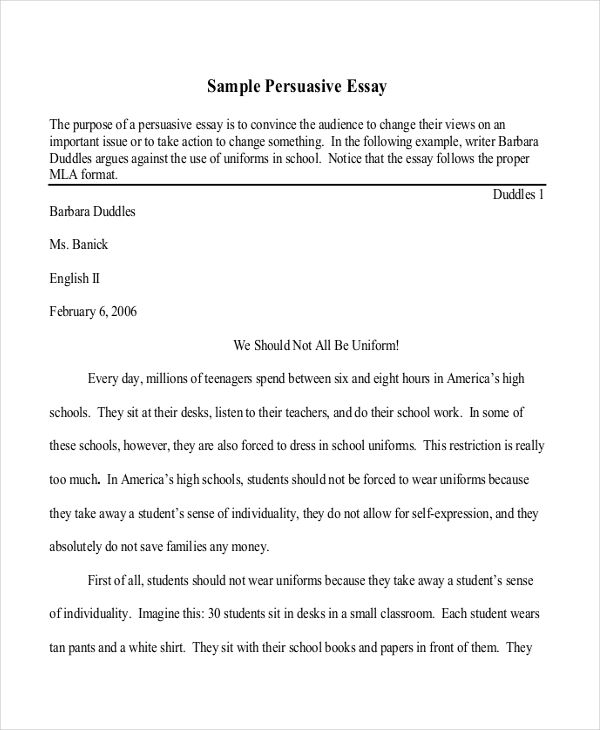
The Five-Step Writing Process for Persuasive Essays. 1. Prewriting for the Persuasive Essay. The prewriting phase of writing a persuasive essay is extremely important. During this phase, students should 2. Drafting the Persuasive Essay. 3. Revising the General Tips on How to Write a Good Persuasive Essay. 1. Introduction. The first and in fact, the most important part of a persuasive essay structure is the introductory paragraph. The aim of the 2. Body. 3. The Conclusion Virtually all persuasive writing displays an academic and confident tone, as well as the ability to use reason and logic to make a particular point of view seem convincing. Writing a persuasive essay also involves conducting plenty of prior research and collecting facts that can be woven throughout the piece. Topics for persuasive essays
7 Quick Tips for Writing a Great Persuasive Essay
The ancient art of rhetoric dates back to the Classical period of ancient Greece, when rhetoricians used this persuasive form of public speaking to address their fellow citizens in the Greek republics. As time went on, tips on how to write a persuasive essay, rhetoric remained at the center of education in the western world for nearly 2, years. In our modern world, rhetoric is still an integral part of human discourse, utilized by world leaders and students alike to argue their points of view.
Write persuasive essays with confidence. Grammarly can help. Get Grammarly. To be as convincing as Aristotle on the stand, your persuasive essay must be based on sound logic and factual evidence that support the overall argument.
As you begin to think about writing a persuasive essay, here are several tips that will help you argue your topic like a true rhetorician. The first step in writing a persuasive essay is choosing a topic and picking a side.
If the topic is something you believe in, it will make the entire experience of researching, writing, and arguing your perspective more personal. Choosing a topic that appeals to you on an emotional or sentimental level will make its defense easier. Every argument has a counterargument—this is one of the staples of rhetoric, tips on how to write a persuasive essay. To convince your reader to agree with you, you must be knowledgeable of the opposing side.
As important as it is to thoroughly research your topic, identifying and studying both sides of the argument will help you develop the strongest supporting evidence possible. During the research process, gather as much information as you can about the topic at hand. One of the most important elements of your persuasive essay is your thesis statement, which should tell readers exactly what your stance encompasses. And how will I convince my readers that the argument is sound? Outlining your paper will give you a clear view of your argument and the way it develops.
Think critically about the strengths and weaknesses of your argument—where would it be most effective for you to introduce your strongest supporting evidence? Instead, use your outline to get organized from the outset, anchoring each point in evidence, tips on how to write a persuasive essay, and counterargument.
List out all of your major claims and the tips on how to write a persuasive essay that supports each point. Creating a working structure will allow you to break down your argument in a logical and concise order, which will make the writing process more straightforward. The most successful rhetorical arguments draw on three main elements: ethos ethical reasoninglogos logical reasoningand pathos passionate reasoning.
If amassed perfectly, these three components will make your argument so powerfully robust that nobody could disagree. However, this is easier said than done; even master rhetoricians struggle to find a balance of these three elements. Logically, your points must be based in fact and progress in a way that makes sense.
Passionately, you should emphasize your evidence and use strategic repetition to compel your audience. The key is to find a harmony or balance among these three elements, writing with integrity and empathy.
You can only give them the right information, so that they can convince themselves. Real-time suggestions, wherever you write. How to Write a Persuasive Essay Kelly Konya. Students How to Write Masterful Topic Sentences for Essays Students 7 of the Best Life Lessons from Graduation Speeches Students How to Write an Abstract for Your Paper Students What Is Academic Writing? Students How to Juggle All Those Finals Papers at Once Students A Pandemic Thank You Letter to Teachers. Writing, grammar, and communication tips for your inbox.
Write with confidence. Get real-time suggestions wherever you write.
How to Write an Eye-Catching Essay Introduction - Scribbr ��
, time: 4:33The Five-Step Writing Process for Persuasive Essays. 1. Prewriting for the Persuasive Essay. The prewriting phase of writing a persuasive essay is extremely important. During this phase, students should 2. Drafting the Persuasive Essay. 3. Revising the General Tips on How to Write a Good Persuasive Essay. 1. Introduction. The first and in fact, the most important part of a persuasive essay structure is the introductory paragraph. The aim of the 2. Body. 3. The Conclusion Virtually all persuasive writing displays an academic and confident tone, as well as the ability to use reason and logic to make a particular point of view seem convincing. Writing a persuasive essay also involves conducting plenty of prior research and collecting facts that can be woven throughout the piece. Topics for persuasive essays

No comments:
Post a Comment